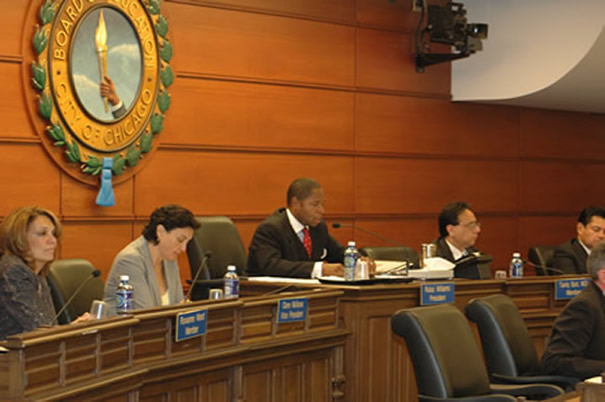CPS IMPACT goes from ‘paperless’ to paper to clean up IMPACT mess
The headlines should have read “Chicago’s paperless office fails. School report cards sent back to paper!”
If there were any semblance of a free press left in Chicago, the memo at the end of this article would have been the subject of news reports, commentary, laughter, drollery, and probably satire at places like Second City.
And if there were any accountability (other than for teachers and children), highly paid heads would be rolling.
Instead, silence.
The memo at the end of this article was distributed quietly by-e-mail to all Chicago public schools on October 3. Its distribution came more than a month after the chaos called IMPACT began in all of Chicago’s more than 600 public 
The subject of the memo was how to provide students with grades in November. Teachers, who had spent dozens of hours or more trying to solve the problems foisted on them by IMPACT, had to give grades to students on November 7 (high schools) and November 8 (elementary schools). Principals were about to face thousands of angry parents and children.
IMPACT was supposed to do the things — in a "paperless" high tech way — that once again will have to be done by hand. But since it was launched in all Chicago public schools in August and September 2007, IMPACT, the new computerized attendance and record keeping system for teachers and schools, has been imploding. Although more public attention has been focused on the other high-tech debacle in Chicago's public schools (a payroll system that is not paying thousands of teachers and other school workers accurately), the impact of IMPACT is at least as great.
According to its supporters and the Power Point marketing it received, IMPACT was supposed to move CPS towards a “paperless” office model as part of transforming Chicago into the nation’s “leading urban public school system.” That's the designation for CPS quoted most in talking points by Chicago Mayor Richard M. Daley, schools CEO Arne Duncan, and those who still proclaim the miracle of Chicago’s “school reform”.
Like many visionary schemes trumpeted in Chicago's public schools lately, IMPACT looked great in Power Point presentations and when its promoters explained what it was supposed to do. But the vision for IMPACT was never realized, and after years of delays, CPS officials ordered it into place this school year, and the vision immediately crashed into the complex reality of Chicago's 600 public schools, 23,000 teachers, and more than 400,000 children.
From the moment teachers across Chicago began trying to use IMPACT in "real time" — the week before Labor Day 2007 — the problems with the program became more and more evident. By the end of the week after Labor Day, the first full week of schools, more than 100 teachers had blogged IMPACT problems on one Chicago education blog, and thousands were facing the same mess that had driven the bloggers to cry out.
CPS officials tried denial. They tried blaming the victim. They tried ignoring the problems (plural: as one teacher said about IMPACT, "The closer you look, the worse it is…"). The Chicago Board of Education met on September 26, one month after IMPACT began crashing, and managed to conduct an entire meeting without discussing the problems that were undermining the school system's entire record-keeping, grading, and attendance systems.
In fact, the September 26 Board of Education meeting began with what amounted to an IMPACT joke: "How can he know?"
At the beginning of the September 26 Board meeting, Board president Rufus Williams proudly announced that CPS had had its best first day attendance in history. Williams said that "93 percent" of CPS students had been in school on the first day of school. Over Labor Day weekend, CPS officials, including CEO Arne Duncan, had staged well-covered media events supposedly getting children to come to school.
But the numbers, which were supposed to have been provided to school officials through IMPACT, simply weren't there. So CPS officials conjured up other numbers, announced another Chicago miracle, and continued repeating it through the Board's September 26 meeting.

IMPACT did not allow most teachers to enter attendance, but other problems grew as the school year began and progressed. And there was no backup system in place if IMPACT failed. Like the conquistadors whose ships were burned so there was no turning back, the CPS leadership ordered that IMPACT's electronic predecessors be destroyed.
Within a week after the city was forced on IMPACT, it was clear that IMPACT was, at best, in its early stages of development and not ready for use system wide. But what Arne Duncan and the system’s chief technology officer (Duncan’s friend Robert Runcie) did instead was release IMPACT system-wide without completing the testing of the program and without a backup system in case IMPACT crashed.
The main questions were never asked despite the growing evidence of a combination of arrogance, incompetence, cronyism and massive waste in IMPACT.
Why did the Chicago Board of Education allowed its information systems people to try what amounted to a “Beta” version of a massive “mission critical” program out without a backup in case the program failed?
How was it that the supposedly business savvy members of the city’s appointed school board didn’t hold anyone in administration “accountable” for the massive and expensive mistake called IMPACT.
Every month, the Chicago Board of Education fires teachers, janitors, and even principals for far less than screwing up a multi-million dollar computer system and the lives of hundreds of thousands of people.
Hundreds of thousands of teacher and other staff hours in September and October were required to work around the mess created by IMPACT and the CPS search for the “paperless office.”
But in early October — as if to add insult to additional insult atop greater and greater injury — teachers were told to go to the “paperless” office to get the paper needed to save the schools from the paperless debacle they had just survived. To prepare the paper-based materials that would be needed the first weeks of November so they could award grades to the more than 400,000 students attending Chicago’s public schools, teachers and principals had to go to IMPACT, which had created the problems in the first place.
After more than a month of chaos in the city’s public schools because of a multi-million dollar computer program that was supposed to render CPS “paperless” but didn’t, the third largest school system in the USA took an interesting turn in its trek towards the “paperless office.”
Teachers were directed to get the paper they needed to save the paperless system from the paperless system. The key paragraph in the October 3 memo reads as follows:
“Tomorrow morning [October 4, 2007], a blank copy of a paper-based progress report will also be available on the IMPACT Web site at http://impact. cps.k12.il.us/ publications.asp <https:// cpsmail.cps.k12.il. us/exchweb /bin/redir.asp?URL= http://impact .cps.k12.il.us /publications.asp> . This blank report is available so that you may direct your staff members to write out progress reports if you feel it is necessary,” The October 3 memo read at its key point.
To get back to the paper you need to save your students from the chaos created by the “paperless office” you have to go to the “paperless” system that created the chaos in the first place. That’s what the following memo translates to:
"From: IMPACT
"Sent: Wednesday, October 03, 2007 2:36 PM
"Subject: IMPACT Performance Issues and Solutions
"Chicago Public Schools Instructional Management Program & Academic "Communication Tool [IMPACT]
"125 South Clark Street, 18th Floor, Chicago, Illinois 60603
"Telephone 773/553-1300, Fax 773/553-4705
"MEMORANDUM
"TO: High School Principals
"Cc: All Area Instructional Officers; All Management Support Directors; All Technology Coordinators; Robert W. Runcie, Chief Information Officer; Dr. Barbara Eason-Watkins, Chief Education Officer; Hill Hammock, Chief Administrative Officer; David Gilligan, Chief Officer of High Schools and High School Programs; Aarti Dhupelia, Broad Resident with AMPS
"FROM: IMPACT Team
"DATE: October 3, 2007
"RE: IMPACT Performance Issues and Solutions
"As you may be aware, IMPACT was unavailable for a period of time this morning. The IMPACT team is working diligently to identify the underlying cause of this problem to ensure that schools are able to produce Progress Reports. More importantly, the team would like to ensure that these issues do not occur during report card grading in November.
"Please encourage your staff members to enter grades into IMPACT SIM so that they become accustomed to this grade reporting process. Additionally, the IMPACT team recommends that schools develop contingency plans for generating the appropriate reports. For your contingency plan, the IMPACT team is making Progress Reports available in Verify starting Thursday morning. Tomorrow morning, a blank copy of a paper-based progress report will also be available on the IMPACT Web site at http://impact.cps.k12.il. us/publications.asp <https://cpsmail. cps.k12.il.us/exch web/bin/redir. asp?URL=http:// impact.cps. k12.il. us publications.asp> .
"This blank report is available so that you may direct your staff members to write out progress reports if you feel it is necessary. We truly apologize for the inconvenience this may have caused your school and your staff members.
"Please direct questions to the IMPACT Help Desk at (773) 553-3925, option 2, or impact @cps.k12.il.us < mailto:impact@cps.k12.il.us> .
"Thank you for your cooperation."


